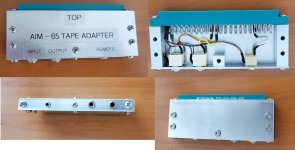Hugo Holden
Veteran Member
I had never used my AIM-65 with tape storage, so I thought I would have a go connecting to a Tape Deck.
All did not go as smoothly as planned.
Firstly I didn't like the idea shown in the manual on connecting the lead wires to an Edge connector. I figured it would be a lot better to combine the edge connector with a metal shell and fit 2.5mm & 3.5mm panel sockets to it, this way standard link audio cables can be used, much like they did on the SOL-20, they had these connectors on the SOL's mobo. So it took me a while to construct that.
After that, the problems began.
I did not have any known good recordings on hand and I was not sure if it was a record or playback issue.
I could record a file to tape and play the tape back, it looked like reasonable looking data on the scope. However, the recording was not recognized on a load and the computer would just hung waiting for the file. I confirmed the playback signal was reaching the 6522 VIA ok.
I examined both the output signal on pin 8 of Z5 and the recovered playback signal on pin 7 of Z 8, the zero crossing detector, and the data looked respectable on playback, but after a while I noticed an odd peculiarity; the data output for recording, measured on the output of the gate Z5 pin 8, had regular lower frequency breaks in it, but oddly, the recovered audio on playback didn't.
Just as I was pondering why, I noticed that one leg of the audio output coupling capacitor C5 was broken off. Yet, despite that, where you might think the tape recording would be totally zero, the tape deck's sensitive mic input was picking up enough signal by stray coupling, to make a form of a recording, even from the low level output I had selected. But, the signal was so heavily differentiated, basically just recording high frequency transients, it was corrupted and a bad recording was made. Now fixed.
All did not go as smoothly as planned.
Firstly I didn't like the idea shown in the manual on connecting the lead wires to an Edge connector. I figured it would be a lot better to combine the edge connector with a metal shell and fit 2.5mm & 3.5mm panel sockets to it, this way standard link audio cables can be used, much like they did on the SOL-20, they had these connectors on the SOL's mobo. So it took me a while to construct that.
After that, the problems began.
I did not have any known good recordings on hand and I was not sure if it was a record or playback issue.
I could record a file to tape and play the tape back, it looked like reasonable looking data on the scope. However, the recording was not recognized on a load and the computer would just hung waiting for the file. I confirmed the playback signal was reaching the 6522 VIA ok.
I examined both the output signal on pin 8 of Z5 and the recovered playback signal on pin 7 of Z 8, the zero crossing detector, and the data looked respectable on playback, but after a while I noticed an odd peculiarity; the data output for recording, measured on the output of the gate Z5 pin 8, had regular lower frequency breaks in it, but oddly, the recovered audio on playback didn't.
Just as I was pondering why, I noticed that one leg of the audio output coupling capacitor C5 was broken off. Yet, despite that, where you might think the tape recording would be totally zero, the tape deck's sensitive mic input was picking up enough signal by stray coupling, to make a form of a recording, even from the low level output I had selected. But, the signal was so heavily differentiated, basically just recording high frequency transients, it was corrupted and a bad recording was made. Now fixed.

